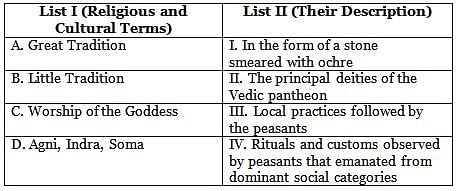CUET History Previous Year Solved Paper 4 (8 August 2022 Slot-1) - Humanities/Arts MCQ
30 Questions MCQ Test Humanities CUET Topicwise Solved Papers - CUET History Previous Year Solved Paper 4 (8 August 2022 Slot-1)
Some of the Harappan cities were specialised centres for making shell objects - including bangles, ladles and inlay, which were taken to other settlements. Which of the following were such specialised centres?
A. Kalibangan
B. Rakhigarhi
C. Nageshwar
D. Mohenjodaro
E. Balakot
A. Kalibangan
B. Rakhigarhi
C. Nageshwar
D. Mohenjodaro
E. Balakot
Match List I with List

Choose the correct answer from the options given below:

| 1 Crore+ students have signed up on EduRev. Have you? Download the App |
Which of these are correct?
A. Early Indus Civilisation - Earnest Mackay
B. Origins of Civ ilisation - Raymond and Bridget Allchin
C. Cultured Civ ilisation - R. E. M. W heeler
D. The Indus Civilisation - G. L. Possehl
E. Understanding Harappa - Shareen Ratnagar
Choose the correct answer from the options given below:
A. Early Indus Civilisation - Earnest Mackay
B. Origins of Civ ilisation - Raymond and Bridget Allchin
C. Cultured Civ ilisation - R. E. M. W heeler
D. The Indus Civilisation - G. L. Possehl
E. Understanding Harappa - Shareen Ratnagar
Choose the correct answer from the options given below:
The languages in which the Ashokan inscriptions were written:
Means of claiming high status by Kushanas was to identify with variety of deities.
Which of the following statements does not hold true to prove the statement?
First ruler in India to issue coins that can be definitively attributed to particular king were ______.
_________ is the term used when descent is traced through the mother.
A critical edition of Mahabharata was prepared by:
The Sanskrit play Mrichchhkatika was written in the fourth century by -
Match List I with List II

Choose the correct answer from the options given below:
According to the ancient Sanskrit religious tex ts, women had access to which of the following?
This Buddhist text included rules and regulations for those who joined the Sangha and monastic order.
Who found the serv ices of the slaves indespensible for carrying women and men on palanquins or dola?
Which am ong the following was a great poet and musician who was the disciple of Hazrat Nizamuddin Auliya?
Match List I with List II

Choose the correct answer from the options given below:
Which of the following statements regarding Baba Guru Nanak Dev are correct?
A. He was born in Nankara Sahib
B. He advocated a form of Saguna Bhakti
C. He expressed his ideas through Shabdas in Punjabi
D. He laid the foundation of Khalsa Panth
E. He appointed Guru Angad Dev as his Successor
Choose the correct answer from the options given below:
Match List I with List II

Choose the correct answer from the options given below:
Which of the following are the correct statements about king Krishnadeva Raya?
A. Krishnadeva belonged to Saluva dynasty
B. He defeated Bijapur and Golconda in the battle of Talikota
C. He is credited with building temples and gopurmms
D. He founded Suburban township as Nagalapuram
E. He expanded and consolidated the Vijayanagar empire
Choose the correct answer from the options given below:
Where is Brihadeshwara temple located?
Ahom kings belonged to;
Who described painting as a 'Magical Art'?
The Ibadat Khana was famous for:-
Which of the following statements regarding mansabdari system of Mughals are true?
A. It was the military-cum -bureaucratic apparatus of the Mughal administration
B. The mansabdars were paid in cash or in jagirs
C. Two numerical designations were given to mansabs - zat and swar
D. The mansabdars of 1,000 Zat were ranked as 'Mir Baksti'.
E. The mansabdars were also called as chaudhari and qazi
Choose the correct answer from the options given below: (
Who made the Persian language as the official language in the Mughal Court?
Akbar sent an ambassador to invite Jesuit priests from;
According to the East India Company's Sunset law:
The battle between the hoe and the plough continued for long. The hoe and the plough were the symbols of:
Which of the following was the first prov ince in India where the colonial rule of East India Company was established?
Who introduced Zamindari system during East India Company rule?
Why Amravati did not survive ?

















